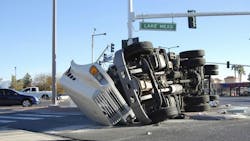NHTSA: Large truck crash fatalities increased in 2016
According to data released by the National Highway Traffic Safety Administration (NHTSA), 4,317 fatalities occurring last year in crashes involving large trucks, which is 5.4% higher when compared to 2015 and is also the highest level of large truck crash deaths since 2007.
Of those 4,317 fatalities, 722 or 16.7% were “occupants” of large trucks – which is up 8.6% from 665 deaths in 2016, NHTSA noted – with 10.8% “non-occupants” and 72.4% occupants of other vehicles.
Overall, 37,461 lives were lost on U.S. roads in 2016, an increase of 5.6% from calendar year 2015, according to the agency, with the number of vehicle miles traveled (VMT) on U.S. roads in 2016 increasing by 2.2% and thus resulting in a fatality rate of 1.18 deaths per 100 million VMT – a 2.6% increase when compared to 2015.
NHTSA found that distracted driving and drowsy driving fatalities declined, while deaths related to other reckless behaviors – including speeding, alcohol impairment, and not wearing seat belts – continued to increase, with motorcyclist and pedestrian deaths accounted for more than a third of the year-over-year increase in highway fatalities.
Other 2016 highway fatality data released by NHTSA included:
- Distraction-related deaths (3,450 fatalities) decreased by 2.2%;
- Drowsy-driving deaths (803 fatalities) decreased by 3.5%;
- Drunk-driving deaths (10,497 fatalities) increased by 1.7%;
- Speeding-related deaths (10,111 fatalities) increased by 4.0%;
- Unbelted deaths (10,428 fatalities) increased by 4.6%;
- Motorcyclist deaths (5,286 fatalities – the largest number of motorcyclist fatalities since 2008) increased by 5.1%;
- Pedestrian deaths (5,987 fatalities – the highest number since 1990) increased by 9%;
- Bicyclist deaths (840 fatalities – the highest number since 1991) increased by 1.3%.
The percentage of fatalities in multi-vehicle rollovers increased the most at 9.1%. However, the number increase for this crash type (an additional 130 fatalities) is a relatively small increase compared to the other crash types in the figure, the agency stressed.
The proportion increase in nighttime fatalities jumped 6.3% compared to the daytime fatality increase of 4.8%, while the proportion increase in weekend fatalities increased by 5.9% compared to an increase of 5.3% on weekdays, NHTSA noted.
Fatalities in single vehicle crashes increased by 1,180, a 5.9% increase, while multi-vehicle crash fatalities also increased, but by a lower rate of 5.1%.
Every month except January, August, and December witnessed increases in fatalities from 2015 to 2016, the agency added, with the highest increase occurring in February at 22.7%.
The number of young drivers 16 to 20 years old involved in fatal crashes increased by 3.6% in 2016 compared to 2015, NHTSA said, with the number of young drivers who died in fatal crashes also increasing but only by 0.1% year-over-year.
